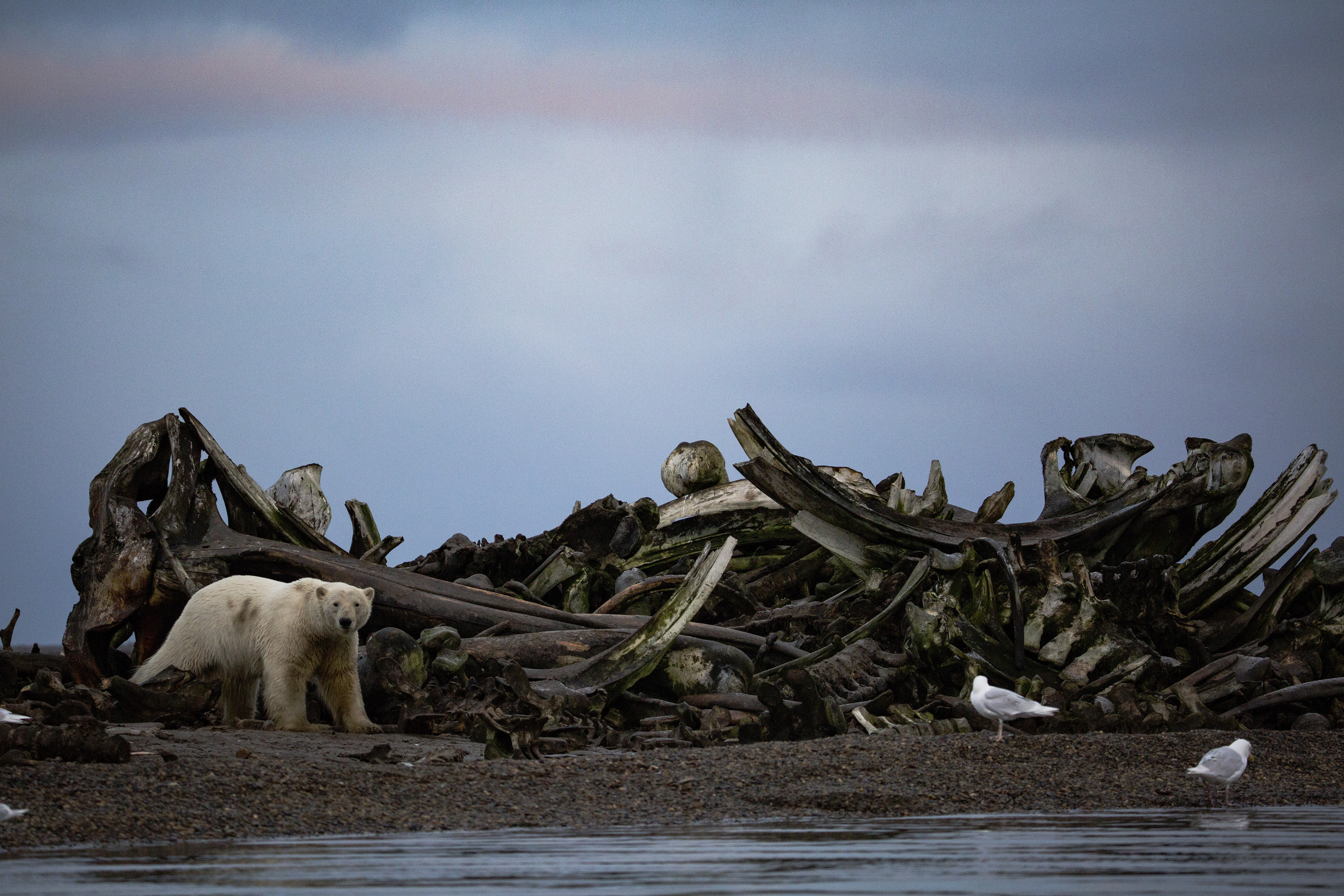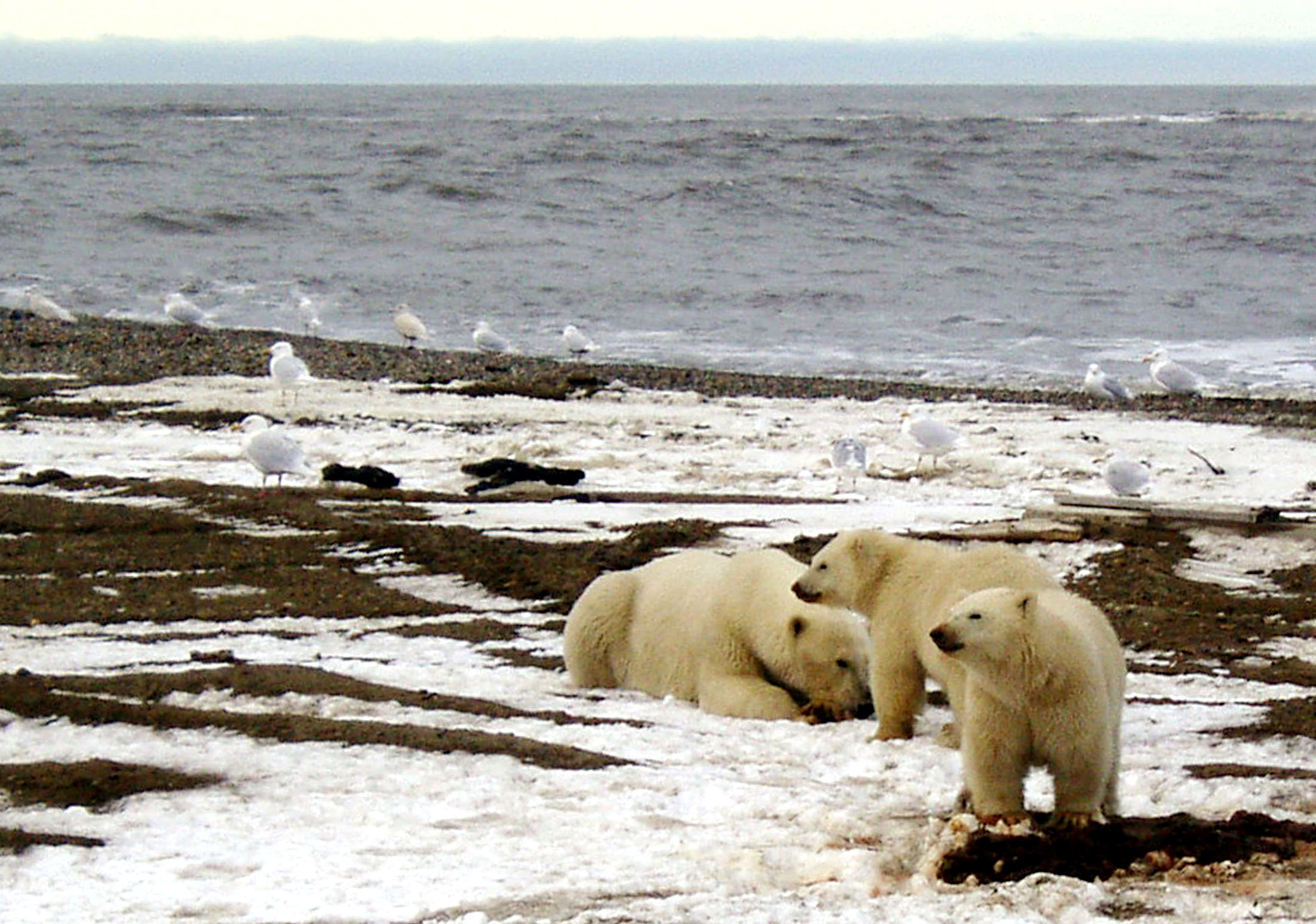Polar bears’ switch to land foods showing up in lowered mercury levels
For polar bears pushed to shore as summer sea ice vanishes, there appears to be a side benefit — mercury levels are dropping as the animals switch to land-based food sources.
A study analyzing hairs of Southern Beaufort Sea polar bears, a population group hard hit by sea-ice melt, found steep declines in mercury, a metal contaminant that in the past was found in high concentrations in that population. Hair can provide a historical record of contaminants like mercury.
The average decline in mercury concentration for adult polar bears sampled from 2004 to 2011 was 13 percent a year, according to the study, published Wednesday in the journal Environmental Science & Technology. That decline was mostly among adult males; mercury concentrations fell by an average rate of 15 percent a year for them, compared to 4.4 percent a year for adult females. The study used nearly 200 samples taken mostly in the spring seasons of those years. It is part of a series of U.S. Geological Survey-supported studies examining climate-related changes to polar bear diets and well-being.

The logical explanation for the mercury decline is the switch in many bears’ diets from ringed seals to other foods — mostly scraps salvaged from bowhead whale bone piles left on beaches by local Inupiat hunters, said biologist Todd Atwood, leader of the USGS polar bear research team and a co-author of the study.
There is no evidence that mercury is declining in the Beaufort Sea environment or in the region’s ringed seals, the traditional prey for polar bears, Atwood said.
“We can’t say that the mercury’s going down in the environment,” he said. “It appears that there are some changes in polar bear behavior that changes their exposure to mercury.”
[There are fewer seals on the menu for Svalbard’s polar bears]
Ringed seals, as fish eaters fairly high on the food chain, tend to accumulate higher mercury concentrations than do other species, he said. Bowhead whales, in contrast, are baleen feeders and tend to accumulate much lower mercury concentrations, he said.
The lower mercury concentrations in bowheads probably explain the male-female split found in the polar bear hair samples, Atwood said.
“Males tend to monopolize a lot of the time at the bone pile,” he said. “Males have a larger percentage of bowhead whale in their diet.”
The bone piles, which accumulate after the autumn hunts and coincide with the maximum sea-ice melt, have become important and dependable food sources for many polar bears. Since the 1990s, the open-water season in the Southern Beaufort Sea has expanded by 36 days a year and polar bears there have been spending 31 more days on shore, mostly attracted to the bone pile, according to a previous study by Atwood and his colleagues.

Another relatively new food source for polar bears is bearded-seal meat, and it is also a lower-mercury food than ringed-seal meat. Bearded seals’ diet is different from that of ringed seals, with clams and other shellfish making up an important part, resulting in lower mercury concentrations.
In previous years, the Southern Beaufort Sea polar bears had some of the highest mercury concentrations among all the species’ population groups, according to a 2011 study. The newly documented decreases are significant, Atwood said.
Mercury is an issue of longstanding concern in the Arctic, but signals about trends are mixed.
[Eastern Arctic polar bears are doing OK — for now]
Atmospheric and ocean currents carry mercury pollution, such as that produced by coal burning, over vast distances into the far north. Thawing permafrost also releases mercury into the environment. Wildfires and volcanic eruptions are natural sources of mercury.
Climate change and human activities put mercury into the Arctic environment, but at the same time governments are taking steps to reduce emissions through the Minamata Convention on Mercury.
For people who depend on wild Arctic marine food for their diets, there are also mixed messages about mercury and other contaminants. Risks of contaminants have to be balanced against the overall benefits of traditional foods — and the risks of replacing them with unhealthful and more processed foods, experts say.
In Alaska, there has been much study of mercury in fish, and the Department of Health and Social Services has issued some cautionary consumption guidelines for certain long-lived species that have been shown to accumulate higher levels of mercury in certain regions. The department has not issued guidelines about mercury risks from consumption of marine mammal meat. The department has been monitoring mercury levels in the hair of Alaska women under a voluntary program that started in 2002.
The reduced polar bear mercury concentrations found in the new study are associated with higher body-mass index — and that is another trouble sign for polar bears that are not coming to shore to eat at the bowhead bone pile.
[Polar bears’ path to decline runs through an Alaska village]
The majority of polar bears stay out at sea, using whatever ice is there, and they spend a lot of time fasting, Atwood said. That causes them to burn body fat and muscle, releasing stored mercury and putting it back into the circulatory system, he said.
For female polar bears, there is other ominous dietary news. Increasingly fragile and mobile ice has forced them to spend more time and energy walking, resulting in greater need for food that is becoming more difficult to find, according to a separate newly published study, also co-authored by USGS scientists.
The study tracked ice and bear movements, comparing data from 1987 to 2013. It found that ice is drifting faster and moving west and north. To compensate, the radio-collared polar bears have been spending more time active or increasing their travel speed, the study found. That boost in activity uses up 1.8 percent to 3.6 percent more energy each year, the equivalent of one to three more seals a year, the study found.
“Increased sea ice drift rates likely exacerbate the physiological stress due to reduced foraging opportunity already experienced by many polar bears in the warming Arctic,” George Durner, a USGS research ecologist and the study’s lead author, said in a statement.